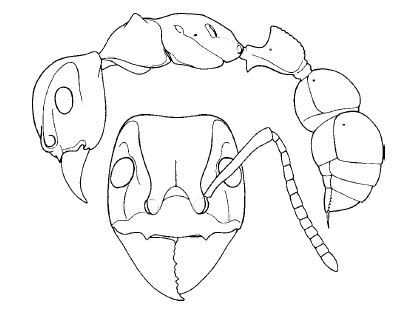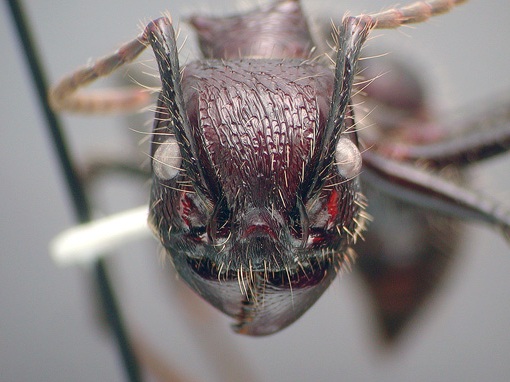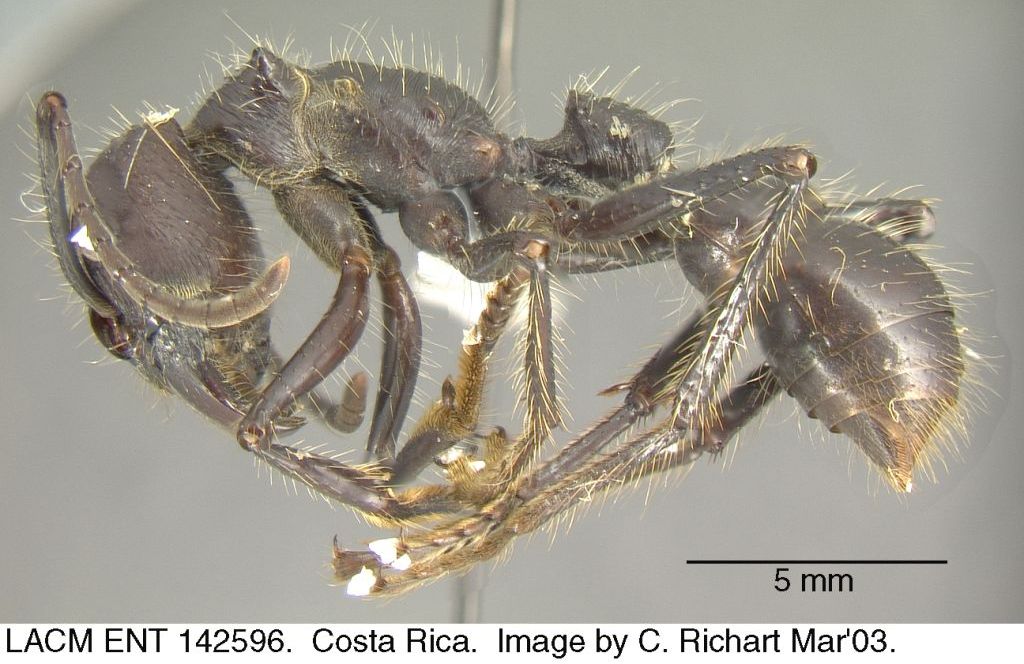|
ЛИТЕРАТУРА ПО ФАУНЕ, ЭКОЛОГИИ И СИСТЕМАТИКЕ

|
Здесь собраны из базы Formis-2003 основные работы (51 статья с Paraponera в заголовке и всего 183 статьи):
-
Baader, A. P. (1996). "The significance of visual landmarks for navigation of the giant tropical ant, Paraponera clavata (Formicidae, Ponerinae)." Insect. Soc. 43: 435-450.
-
Baroni Urbani, C. (1994). "The identity of the Dominican Paraponera (Amber Collection Stuttgart: Hymenoptera, Formicidae. V: Ponerinae, partim)." Stuttg. Beitr. Naturkd. Ser. B (Geol. Palaontol.) 197: 1-9.
-
Barrett, B. A., C. D. Jorgensen, et al. (1985). "Foraging recruitment by the giant tropical ant, Paraponera clavata (Hymenoptera Formicidae)." Pan-Pac. Entomol. 61: 334-338.
-
Belk, M. C., H. L. Black, et al. (1989). "Nest tree selectivity by the tropical ant, Paraponera clavata." Biotropica 21: 173-177.
-
Bennett, B. and M. D. Breed (1985). "On the association between Pentaclethra macroloba (Mimosaceae) and Paraponera clavata (Hymenoptera: Formicidae) colonies." Biotropica 17: 253-255.
-
Bequaert, J.C. (1926): Medical Report of the Hamilton Rice 7th. Expedition to the Amazon. Harvard Univ. Press, pp. 250-253
-
Bolton B. (1992). A new general catalogue of the ants of the world, Harvard University Press, Cambridge, MA.
-
Breed, M. D. (1994). The search for food: The transition from solitary to social foraging in a ponerine ant, Paraponera clavata. Les Insectes Sociaux. 12th Congress of the International Union for the Study of Social Insects, Paris, Sorbonne, 21-27 August 1994. A. Lenoir, G. Arnold and M. Lepage. Paris, Universite Paris Nord: 64.
-
Breed, M. D. and B. Bennett (1985). "Mass recruitment to nectar sources in Paraponera clavata : A field study." Insect. Soc. 32: 198-208.
-
Breed, M. D. and J. Harrison (1989). "Arboreal nesting in the giant tropical ant, Paraponera clavata (Hymenoptera: Formicidae)." J. Kansas Entomol. Soc. 62: 133-135.
-
Breed, M. D. and J. M. Harrison (1988). "Worker size, ovary development and division of labor in the giant tropical ant, Paraponera clavata (Hymenoptera: Formicidae)." J. Kansas Entomol. Soc. 61: 285-291.
-
Breed, M. D., T. M. Stiller, et al. (1991). "Intercolonial interactions and nestmate discrimination in the giant tropical ant, Paraponera clavata." Biotropica 23: 301-306.
-
Breed, M. D. (2002). "Allometry in the giant tropical ant, Paraponera clavata." Insect. Soc. 49(2): 125-128.
Workers of the ponerine ant, Paraponera clavata, grow allometrically, with the head disproportionately larger in larger workers. The anterior (clypeus)-posterior (occiput) dimension of the head capsule is allometric with the lateral (interocular) dimension, so that larger workers have elongate heads. The degree of head capsule allometry varies among colonies; this could result either from differences in colony maturity or from variation in developmental patterns among colonies. These data resolve a previously controversial issue concerning caste in Paraponera clavata.
-
Breed, M. D., R. M. Bowden, et al. (1996). "Giving-up time variation in response of differences in nectar volume and concentration in the giant tropical ant, Paraponera clavata (Hymenoptera: Formicidae)." J. Insect Behav. 9: 659-672.
-
Breed, M. D., C. Stierstorfer, et al. (1996). "Individual constancy of local search strategies in the giant tropical ant, Paraponera clavata (Hymenoptera: Formicidae)." J. Insect Behav. 9: 673-682.
-
Brown, B. V. and D. H. Feener, Jr. (1991). "Behavior and host location cues of Apocephalus paraponerae (Diptera: Phoridae), a parasitoid of the giant tropical ant, Paraponera clavata (Hymenoptera: Formicidae)." Biotropica 23: 182-187.
-
Brown, B. V. and D. H. Feener, Jr. (1991). "Life history parameters and description of the larva of Apocephalus paraponerae (Diptera: Phoridae), a parasitoid of the giant tropical ant Paraponera clavata (Hymenoptera: Formicidae)." J. Nat. Hist. 25: 221-31.
-
Brown Jr., W.L. (1958). Contributions toward a reclassification of the Formicidae. II. Tribe Ectatommini (Hymenoptera). Bull. Mus. Comp. Zool. 118:175-362.
-
Caetano, F. H., M. I. C. Mathias, et al. (1986). "Anatomia e histologia comparada do trato digestivo de Dinoponera gigantea E Paraponera clavata (Formicidae, Ponerinae)." Naturalia 11: 125-134.
= The comparative anatomy and histology of the digestive tract of Dinoponera gigantea and Paraponera clavata (Formicidae, Ponerinae).
-
Dyer, L. A. (2002). "A quantification of predation rates, indirect positive effects on plants, and foraging variation of the giant tropical ant, Paraponera clavata." J. Insect Sci. 2:18: 7 p.
-
Fabricius, J. C. 1775. Systema entomologiae, sistens insectorum classes, ordines, genera, species adiectis synonymis, locis, descriptionibus, observationibus. Flensburgi et Lipsiae [= Flensburg and Leipzig]: Korte, 832 pp.
-
Fernandez, F. (1993). "Hormigas de Colombia III: los generos Acanthoponera Mayr, Heteroponera Mayr y Paraponera Fr. Smith (Formicidae: Ponerinae: Ectatommini)." Caldasia 17: 249-258.
-
Fewell, J. H., J. F. Harrison, et al. (1989). "Variable recruitment strategies in the giant tropical ant, Paraponera clavata. [abstract]." Am. Zool. 29: 17A.
-
Fewell, J. H., J. F. Harrison, et al. (1992). "Distance effects on resource profitability and recruitment in the giant tropical ant, Paraponera clavata." Oecologia 92: 542-547.
-
Fewell, J. H., J. F. Harrison, et al. (1996). "Foraging energetics of the ant, Paraponera clavata." Oecologia 105: 419-427.
The energy currencies used by foraging animals are expected to relate to the energy costs and benefits of resource collection. However, actual costs of foraging are rarely measured. We measured the ratio of energetic benefit relative to cost (B/C) during foraging for the giant tropical ant, Paraponera clavata. The B/C ratio was 3.9 for nectar-foragers and 67 for insect prey foragers. In contrast, the B/C ratio during foraging for seed harvester ants (Pogonomyrmex occidentalis) is over 1000, demonstrating that the B/C ratio can vary widely among ants. The B/C ratio was 300 times lower for nectar-foraging Paraponera than for the seed-harvesting Pogonomyrmex because of: (1) a 5-fold lower energetic benefit per trip, (2) a 10-fold greater cost due to longer foraging distances, and (3) a 6-fold greater energy cost per meter due to larger body size. For Paraponera daily colonial energy intake rates are similar to expenditures and may limit colony growth and reproduction. In contrast, for Pogonomyrmex energy intake rates are an order of magnitude higher than estimated costs, suggesting that Pogonomyrmex colonies are unlikely to be limited by short-term energy intake. We suggest that variation in individual B/C ratios may explain why the foraging behavior of Paraponera but not Pogonomyrmex appears sensitive to foraging costs.
-
Fritz, G., A. S. Rand, et al. (1981). "The aposematically colored frog, Dendrobates pumilio, is distasteful to the large, predatory ant, Paraponera clavata." Biotropica 13: 158-159.
-
Harrison, J. M. and M. D. Breed (1987). "Temporal learning in the giant tropical ant, Paraponera clavata." Physiol. Entomol. 12: 317-320.
-
Hermann, H. R. (1975). "Crepuscular and nocturnal activities of Paraponera clavata (Hymenoptera: Formicidae: Ponerinae)." Entomol. News 86: 94-98.
-
Hermann, H. R. and M. S. Blum (1966). "The morphology and histology of the hymenopterous poison apparatus. I. Paraponera clavata (Formicidae)." Ann. Entomol. Soc. Am. 59: 397-409.
-
Hermann, H. R., M. S. Blum, et al. (1984). "Comparative anatomy and chemistry of the venom apparatus and mandibular glands in Dinoponera grandis (Guerin) and Paraponera clavata (F.) (Hymenoptera: Formicidae: Ponerinae)." Ann. Entomol. Soc. Am. 77: 272-279.
The furcula in these two species is X shaped. Very large mandibular glands attach to the mesal side of each mandible. Dufour's gland secretion in D. grandis workers contains a series of saturated, monounsaturated, and diunsaturrated hydrocarbons in the range from C13 to C19, with pentadecane being the major alkane present. The mandibular gland secretion consists of 2,5-dimethyl-3-n-propylpyrazine and 2,5-dimethyl-3-isopentylpyrazine. Dufour's gland secretion of P. clavata is dominated by nonadecadiene, pentacosadiene, and heptacosadiene, with a series of alkanes and alkenes from C16 to C29 also present. Mandibular gland secretions consist of a mexture of 4-methyl-3-heptanone and 4-methyl-3-heptanol.
-
Hermann, H. R. and A. M. Young (1980). "Artificially elicited defensive behavior and reciprocal aggression in Paraponera clavata (Hymenoptera: Formicidae: Ponerinae)." J. Georgia Entomol. Soc. 15: 8-10.
-
Holldobler, B. and E. O. Wilson (1990). "Host tree selection by the neotropical ant Paraponera clavata (Hymenoptera: Formicidae)." Biotropica 22 (2): 213-214.
extract: ґColonies of the giant ponerine ant Paraponera clavata nest at the bases of trees throughout a wide range in Central and South America. At the La Selva Field Station (..), Costa Rica, the ants prefer but do not limit themselves to Pentaclethra macroloba, a mimosaceous tree that is by far the most abundant species in the tropical moist forest of the region. (...) It thus appears that Paraponera queens actively choose Pentaclethra over at least some of the other available tree species, probably by chemoreception. On the other hand, the result must be considered weak, due to the fact that only two queens were availabla for testing. (..)
-
Janzen, D. H. and C. R. Carroll (1983). Paraponera clavata (bala, giant tropical ant). Costa Rican natural history. D. H. Janzen. Chicago. 816 p., University of Chicago Press: 752-753.
-
Jorgenson, C. D., H. L. Black, et al. (1984). "Territorial disputes between colonies of the giant tropical ant Paraponera clavata (Hymenoptera:Formicidae:Ponerinae)." J. Georgia Entomol. Soc. 19: 156-158.
-
Kannowski, P. B. (1991). "Occurrence of alates of the neotropical ant, Paraponera clavata (Hymenoptera, Formicidae), at lights during the dry-wet seasons interface in Panama." J. Entomol. Sci. 26: 375-377.
*[Includes unpublished data from Costa Rica.]
-
LeClerc, M. G., D. C. McClain, et al. (1987). "An inquiline relationship between the tailless whip-scorpion Phrynus gervaisii and the giant tropical ant Paraponera clavata." J. Arachnol. 15: 129-130.
-
McCluskey, E. S. and W. L. Brown (1972). "Rhythms and other biology of the giant tropical ant Paraponera." Psyche 79: 335-347.
-
Morehead, S. A. and D. H. Feener, Jr. (2000). "An experimental test of potential host range in the ant parasitoid Apocephalus paraponerae." Ecol. Entomol. 25: 332-340.
1. The work reported here tested experimentally whether specialisation in Apocephalus paraponerae was due to physiological interactions that limit the parasitoid to the host ant Paraponera clavata. The suitability of other ant species as hosts was tested, and behavioural traits that may promote a high degree of specificity within this host-parasitoid system are discussed. 2. Data for development time, number of puparia, and adult eclosion success for A. paraponerae ovipositing in the regular host P. clavata are provided. A new method for testing host suitability in parasitoids of ants is described. Eggs of A. paraponerae were transferred directly into potential ant hosts. The development time, number of puparia, and adults eclosed for the eggs transferred into other ant host species are compared with comparable data from P. clavata. 3. Seven ant species within the Ponerinae are suitable for the development of A. paraponerae . The potential host range is greater than the actual host range of A. paraponerae. Flies are not limited solely by host suitability of related ant species for the development of larvae. Host location and acceptance behaviours are proposed as the primary reasons for host specialisation. The large size of the primary host P. clavata, and the ability of multiple females to raise many offspring successfully from those hosts may influence the specialisation of A. paraponerae on P. clavata.
-
Nelson, C. R., C. D. Jorgensen, et al. (1991). "Maintenance of foraging trails by the giant tropical ant Paraponera clavata (Insecta: Formicidae: Ponerinae)." Insect. Soc. 38: 221-228.
-
Perez, R., R. Condit, et al. (1999). "Distribution, mortality and association with plants of Paraponera clavata (Hymenoptera: Formicidae) nests in Barro Colorado Island, Panama." Rev. Biol. Trop. 47: 697-709.
*[Nest density at BCI was 6.2 nests per hectare.] *Cited from: Dyer, L.A., 2002, A quantification of predation rates, indirect positive effects on plants, and foraging variation of the giant tropical ant, Paraponera clavata, J. Insect Sci. 2:18, 7 p.
-
Piek, T., A. Duval, et al. (1991). "Poneratoxin, a novel peptide neurotoxin from the venom of the ant, Paraponera clavata." Comp. Biochem. Physiol. C Comp. Pharmacol. Toxicol. 99: 487-495.
1. At concentrations varying from 10(-8) to 10(-6) M synthetic poneratoxin (PoTX) is a strong, but very slowly acting agonist for smooth muscles and its blocks synaptic transmission in the insect CNS in a concentration-dependent manner and depolarizes giant interneurons. 2. However, in isolated dorsal unpaired median cells 10(-6)M PoTX causes only a reversible hyperpolarization of about 5 mV. 3. At concentrations from 10(-8) to 10(-6)M PoTX affects the electrical activity of isolated cockroach axons, as well as isolated frog and rat skeletal muscle fibres. 4. PoTX prolongs action potentials and induces slow automatic activity, due to a slow Na+-current activation at very negative values of potential and due to slow deactivation.
-
Piek, T., B. Hue, et al. (1991). "Pharmacological characterization and chemical fractionation of the venom of the ponerine ant, Paraponera clavata (F.)." Comp. Biochem. Physiol. C Comp. Pharmacol. Toxicol. 99: 481-486.
1. The neurotoxic action of the venom of the ponerine ant, Paraponera clavata, was studied using a cascade of mammalian smooth muscle preparations and a preparation for investigating transmission from fibres of the cercal nerve to a giant interneuron in the sixth abdominal ganglion of the cockroach. 2. The venom contains three toxic fractions that block synaptic transmission in the insect central nervous system. 3. Two of these fractions have agonistic action on mammalian smooth muscle preparations. 4. One of the later fractions was characterized pharmacologically as containing a kinin. 5. The other, and most active neurotoxic fraction, was rechromatographed, resulting in the purification of a peptide of 25 amino acids residues, called poneratoxin, PoTX: Phe-Leu-Pro-Leu-Leu-Ile-Leu-Gly- Ser-Leu-Leu-Met-Thr-Pro-Pro-Val-Ile-Gln-Ala-Ile-His-Asp-Ala-Gln-Arg-Hn2.
-
Piek, T., B. Hue, et al. (1990). "A neuroactive kinin from the venom of the ant Paraponera clavata." Toxicon 28: 162.
-
Porter, C. A., P. Thompson, et al. (1986). "Genetic variability in a population of Paraponera clavata (Hymenoptera: Formicidae)." Southwest. Nat. 31: 381-385.
-
Sevcik, C. and C. J. Hernandez (1990). Some findings on neurotoxins from the venom of the giant ant, Paraponera clavata. Applied myrmecology: a world perspective. R. K. Vander Meer, K. Jaffe and A. Cedeno. Boulder, CO. 741 p., Westview Press: 461-471.
-
Silberglied, R.E. & Aiell0, A. (1976): Defensive adaptations of some Neotropical long-horned beetles (Coleoptera: Cerambycidae). Psyche 83:256-262.
-
Thurber, D. K., M. C. Belk, et al. (1993). "Dispersion and mortality of colonies of the tropical ant Paraponera clavata." Biotropica 25: 215-221.
-
Weber, N.A. (1937): The sting of an ant. Amer. J. Trop. Med. 17:765-768.
-
Weber, N. A. (1939). "The sting of the ant, Paraponera clavata." Science 89: 127-128.
-
Wetterer, J. K. (1994). "Attack by Paraponera clavata prevents herbivory by the leaf-cutting ant, Atta cephalotes." Biotropica 26: 462-465.
-
Whiting, J. H., Jr., H. L. Black, et al. (1989). "A scanning electron microscopy study of the mouthparts of Paraponera clavata (Hymenoptera: Formicidae)." Pan Pac. Entomol. 65: 302-309.
-
Wilson, E. O. (1986 ("1985")). "Ants of the Dominican amber (Hymenoptera: Formicidae). 4. A giant ponerine in the genus Paraponera." Isr. J. Entomol. 19: 197-200.
-
Young, A. M. (1977). "Notes on the foraging of the giant tropical ant Paraponera clavata (Formicidae: Ponerinae) on two plants in tropical wet forest." J. Georgia Entomol. Soc. 12: 41-51.
-
Young, A. M. (1981). "Giant neotropical ant Paraponera clavata visits Heliconia pogonantha flower bracts in premontane tropical rain forest." Biotropica 13: 223.
*[Ants observed scraping conspicuous perianth on plant bract. Not observed with drops of liquid or plant material after scraping.]
-
Young, A. M. and H. R. Hermann (1980). "Notes on foraging of the giant tropical ant Paraponera clavata (Hymenoptera: Formicidae: Ponerinae)." J. Kansas Entomol. Soc. 53: 35-55.
*[Atta & other ants brought into the nest as booty. 45% of 4500 returning ants had booty. Of these, 37% carried visible liquid, 25% arthropod prey, & 21% plant parts. Marking studies indicated that the same ants foraged on different days. Diurnal foraging occurred in Costa Rica; considerable nocturnal foraging occurred in Ecuador.]
|



